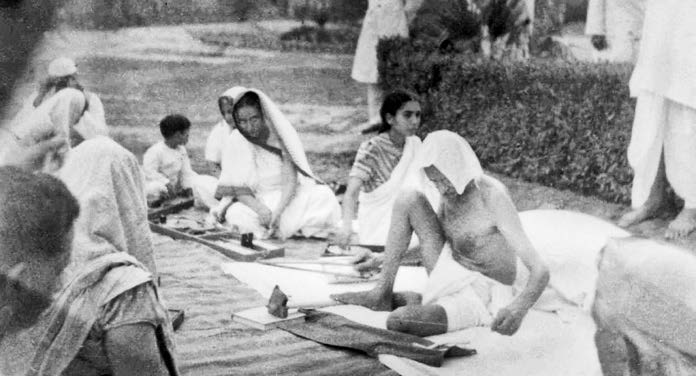
Some men changed their times...
One man changed the World for all times!
Comprehensive Website on the life and works of
Mahatma Gandhi
+91-23872061
+91-9022483828
info@mkgandhi.org

+91-23872061
+91-9022483828
info@mkgandhi.org
Khadi: The Fabric of Sustainability and Beyond |
- By Aditi H Trivedi*
Mahatma Gandhi as mass spinning, Sevagram, 1941 Khadi, derived from the word khaddar, is not just warp and weft turned into fabric, it is a voice. A voice of the people, of the nonviolence (ahimsa), of the rain, of the sun, of the Earth that align themselves into complete harmony with each other. Never in history, a piece of hand spun and handwoven cloth has played such paramount role in shaping the destiny of the country. In India, clothes have an epoch-making history as they highlight the essence of people who wear them. Khadi has been inclusive as well as significant to ethos of this land. A campaigner for Khadi, Mahatma Gandhi advocated the story of Khadi to weave Indian subcontinent together in early 20th century In modern India, khadi as a livery of freedom was introduced by Mahatma Gandhi as an instrument to meet twin objectives of self-reliance through local production on the one hand and seeking active participation of all, rich and poor, in the struggle for Independence on the other. Gandhiji believed that young countrymen and women should opt for khadi in the struggle for independence which was an invitation to ‘be’ authentic as individual souls in order to ‘become’ true symbols of swaraj. After him, Khadi in later years was to be made commercial and market-oriented. Historically, the fabric played crucial role in helping India free from the rule of its colonisers. Today, Khadi industry is an industry looked over mainly by government through KVIC (Khadi and Village Industries Commission) and KVIB (Khadi and Village Industries Board). The industry helps in the upliftment of rural India by generating employment, providing saleable articles, creation of self-reliance among rural India, and building strong rural community spirit. The revolutionary cloth, in these turbulent times, is a solution for the major environmental crisis that the earth is facing. With more emphasis on sustainability in the textile industry, the consumers embrace eco-friendly and consciously weaved clothes. Khadi has low carbon footprint as it requires limited electricity and no energy for its manufacturing. A meter of khadi fabric consumes three litres of water, while one meter of mill-produced fabric requires 55 litres of the natural resource. Dr. J.C. Kumarappa, the pre-eminent Gandhian economist, emphasised on establishing the ‘economy of permanence’ rather than a system which was based on heedless destruction of our natural resources. Winin Periera and Jermey Seabrook observed in their book, Asking the Earth that “the maintenance of a dynamic equilibrium (in the ecosystem) demands that in a particular region inputs and outputs balance. The inputs consist of energy from the sun, water from the rain, stream or underground sources, carbon dioxide, oxygen and nitrogen from the atmosphere, organic and inorganic chemicals from the soil and so on. Outputs are what is harvested or extracted from the region. If the outputs exceed inputs, the region must degenerate. Such an equilibrium requires the use of renewable resources. No society can survive for a long time if the agriculture is not sustainable.” The World Commission on Environment and Development has also expressed its views on similar lines. It mentions that, “A safe and sustainable energy pathway is crucial to sustainable development. There are constant threats of global warming and acidification of the environment. The planetary ecosystem cannot stand if there is increase in the use of non-renewable fossil fuels. Any new era of economic growth must therefore be less energy intensive than growth in the past.” Hence, the use of khadi is a solution to environmental sustainability. Inspired by Mahatma Gandhi’s words and praxis, this fabric should be elevated to significant status where the industry work towards rural capacity building by focusing on empowering women and encouraging rural economies to be self-sufficient as well as make a contribution towards global warming. Bibliography
References
Khoj Gandhiji Ki, Year 4, Number 3-4, March-April 2022. * Gandhi Research Foundation |